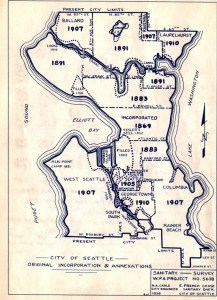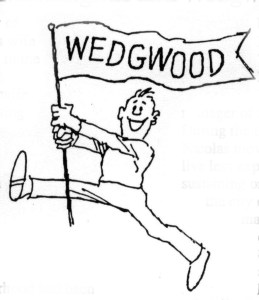One of the most common questions I receive on my blog is about the Seattle City Limits and on what date different areas came into the city.
Some neighborhoods of Seattle such as Ballard and Ravenna started out as separate cities but they found, over time, that they were not able to keep up with the need to have utilities such as water and electricity, and the need of improvements such as roads.
I have written a blog article about how the Wedgwood neighborhood came into the city limits. Annexation of the northeastern areas including Wedgwood, occurred gradually over the 1940s to 1950s with separate sections voting themselves in at different times. It was a controversial process with some people resisting because they thought that coming into the Seattle City Limits would not benefit them.
The northern portion of Wedgwood (north of NE 85th Street) and areas up to 145th Street, including Lake City, were among the last to be included with the final annexation taking effect in 1954.
In 1961 the “directional designations” were changed so that East 75th Street in Wedgwood, for example, became NE 75th Street.
The Seattle Municipal Archives has a map of annexations and a list of the dates of annexations. Here is a link to the annexation info. I am posting the SMA’s essay and info here:
Annexed Cities: (info from Seattle Municipal Archives page)
Seattle grew enormously through annexation between 1905 and 1910. Eight small towns were annexed to the City of Seattle, nearly doubling the physical area of the City.
Many small towns sought a safer and more reliable water supply, a better sewer system, and a supply of electricity. As Seattle became a more urban and less rural city, its texture changed through annexation, adding distinct communities with characters of their own.

A 1938 Seattle Engineering Department map of the city showing the annexations dates of different neighborhoods. A “jog” can be seen at the northeast corner where the City Limits were at NE 65th Street as of 1910. Map from the Seattle Municipal Archives Record Series 2616-03.
Six of the towns – Ballard, Columbia, Ravenna, Southeast Seattle, South Park, and West Seattle – were annexed in 1907. All areas annexed into the City of Seattle in 1907 struggled with concerns of a growing population: sustaining the water and sewer systems, keeping up with street improvements, and public safety issues.
At least two of these, Ravenna and Southeast Seattle, appear to have incorporated as towns specifically for the purpose of petitioning Seattle for annexation. Other towns, such as West Seattle, Ballard, South Park, and Columbia, had their own character and community before becoming part of the City of Seattle. Some of those towns became part of Seattle enthusiastically, and others reluctantly.
While each town had its own reasons for petitioning for annexation, some common themes emerge. Common to all the communities annexed to the City are comments relating to a fading rural way of life. Impounded cows, complaints of the noise of cowbells, and loose livestock all signaled the switch to an increasingly urban lifestyle, although the issues of noise, animals at large, and vandalism have not disappeared even today.
Many had difficulties in securing a safe and ample water supply for their populations, and other utilities like sewers and electricity also caused difficulties for the town councils. It was difficult to keep up with street improvements for their growing populations, and some towns found themselves with growing debt. The towns ended up deciding it was in their best interest to ask that their problems – and their resources – become part of the City of Seattle.

Northeast Seattle, north of NE 65th Street, did not begin to come into the Seattle City Limits until the 1940s and 1950s.
The last of the small towns to be annexed to the City of Seattle was Georgetown (south of downtown), which incorporated in 1904 and was annexed into Seattle April 11, 1910. After this date, no large annexations were made until the early 1950s.
The most common method of annexation was a petition describing the area to be annexed, which had to be contiguous to the City. The petition had to contain valid signatures of at least 20% of the electors who had voted in the last general election in the area and include a request that an election be held. If the Council approved the election, the county checked the validity of the signatures, and an election was held. After the vote, Seattle City Council could accept or reject the annexation, although no vote for annexation was ever refused.
The text of this exhibit was used, in part, to construct a travelling exhibit on annexations and Seattle’s growth in 1907. That exhibit was a joint project of HistoryLink, the Mayor’s Office of Arts and Cultural Affairs, and the Seattle Municipal Archives.
For the key to the map below, go to the map here, with numbers for the date that each section voted itself into the Seattle City Limits.



Interesting read. I live in West Seattle. Between the pandemic and the closure of the bridge, we’re struggling with isolation from the rest of the city again.